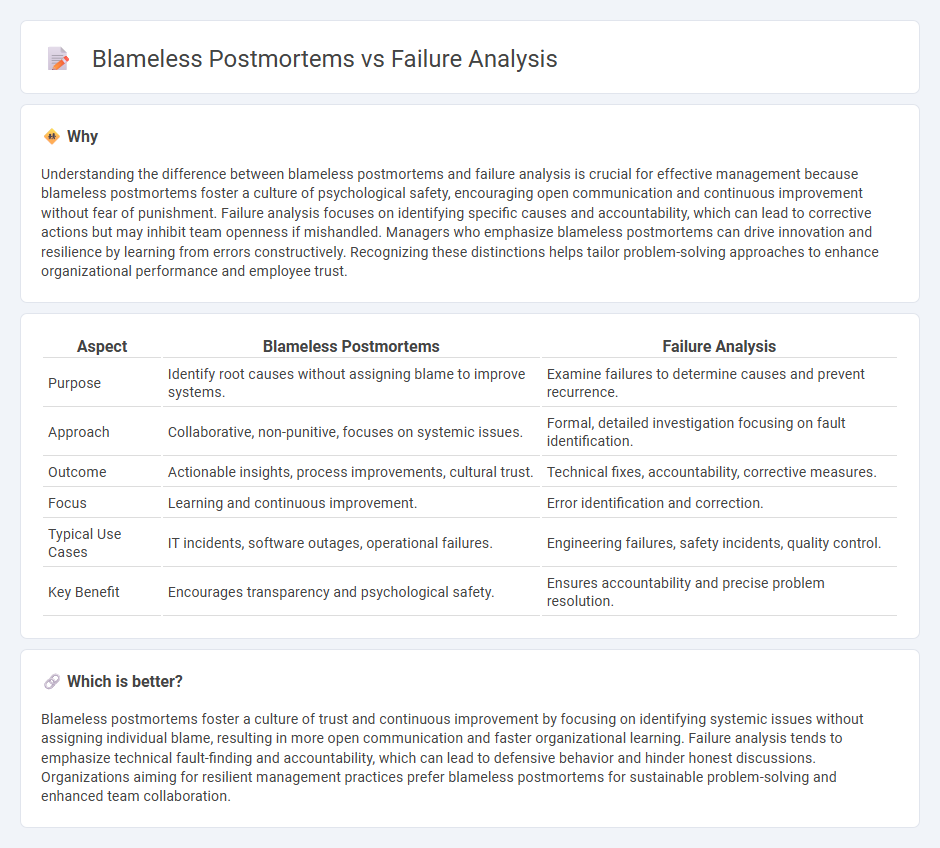
Blameless postmortems focus on understanding system failures without assigning individual blame, fostering a culture of openness and continuous improvement in management practices. Failure analysis, by contrast, often targets specific causes or mistakes, which can sometimes hinder transparent communication. Explore more to learn how adopting blameless postmortems can transform organizational learning and resilience.
Why it is important
Understanding the difference between blameless postmortems and failure analysis is crucial for effective management because blameless postmortems foster a culture of psychological safety, encouraging open communication and continuous improvement without fear of punishment. Failure analysis focuses on identifying specific causes and accountability, which can lead to corrective actions but may inhibit team openness if mishandled. Managers who emphasize blameless postmortems can drive innovation and resilience by learning from errors constructively. Recognizing these distinctions helps tailor problem-solving approaches to enhance organizational performance and employee trust.
Comparison Table
| Aspect | Blameless Postmortems | Failure Analysis |
|---|---|---|
| Purpose | Identify root causes without assigning blame to improve systems. | Examine failures to determine causes and prevent recurrence. |
| Approach | Collaborative, non-punitive, focuses on systemic issues. | Formal, detailed investigation focusing on fault identification. |
| Outcome | Actionable insights, process improvements, cultural trust. | Technical fixes, accountability, corrective measures. |
| Focus | Learning and continuous improvement. | Error identification and correction. |
| Typical Use Cases | IT incidents, software outages, operational failures. | Engineering failures, safety incidents, quality control. |
| Key Benefit | Encourages transparency and psychological safety. | Ensures accountability and precise problem resolution. |
Which is better?
Blameless postmortems foster a culture of trust and continuous improvement by focusing on identifying systemic issues without assigning individual blame, resulting in more open communication and faster organizational learning. Failure analysis tends to emphasize technical fault-finding and accountability, which can lead to defensive behavior and hinder honest discussions. Organizations aiming for resilient management practices prefer blameless postmortems for sustainable problem-solving and enhanced team collaboration.
Connection
Blameless postmortems and failure analysis are interconnected practices that focus on identifying systemic issues rather than individual faults within an organization. Both approaches prioritize transparent communication and collaborative problem-solving to enhance operational resilience and prevent repeat failures. Emphasizing a culture of learning and accountability, these methods drive continuous improvement in management processes and team performance.
Key Terms
Root Cause
Failure analysis targets identifying and understanding the root cause of system failures to prevent recurrence, using detailed technical data and error tracing. Blameless postmortems emphasize creating a culture of trust and continuous improvement by focusing on systemic issues rather than individual faults. Explore how integrating both approaches enhances reliability and team dynamics in your organization.
Accountability
Failure analysis emphasizes identifying errors and assigning responsibility to improve processes and prevent recurrence, often highlighting individual or team accountability. Blameless postmortems prioritize understanding systemic issues and organizational learning without attributing fault, fostering a culture of psychological safety and continuous improvement. Explore how integrating both approaches can enhance accountability while promoting innovation and resilience.
Continuous Improvement
Failure analysis dissects root causes of incidents by systematically identifying and addressing technical and human errors, enabling targeted corrective actions. Blameless postmortems foster a culture of psychological safety by removing individual blame, encouraging transparency and collective learning to enhance system reliability. Explore how integrating these approaches drives continuous improvement and operational excellence in your organization.
Source and External Links
6 Key Analytical Methods to Identify Product Failure Causes - Failure analysis is a systematic process using data collection, non-destructive and destructive testing, and multidisciplinary expertise to determine why a product or component failed and recommend corrective actions.
What is Failure Analysis? - Failure analysis involves examining failed devices to identify root causes, understand failure mechanisms, and implement corrective measures to prevent recurrence, widely used in industries like automotive, aerospace, and electronics.
6 Steps to Conduct Failure Analysis - The process includes defining the problem, collecting relevant failure data, applying appropriate analytical techniques, and reviewing results to develop and test effective solutions.
 dowidth.com
dowidth.com